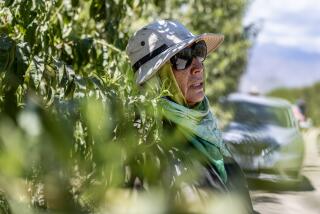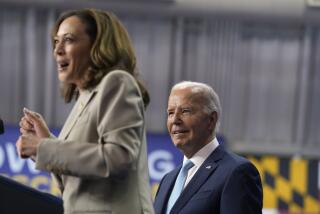Official defends meat inspections
- Share via
WASHINGTON — Agriculture Secretary Edward T. Schafer sparred with Senate lawmakers Thursday, insisting that regulations governing inspections of slaughterhouses are sufficient to ensure the safety of the nation’s meat supply.
Schafer rejected senators’ calls to completely ban from slaughter any cattle unable to walk. “Downer” cows are at higher risk of carrying E. coli and salmonella bacteria and of having the wasting neurological illness known as mad cow disease.
The standoff came at a Senate subcommittee hearing triggered by practices at Westland/Hallmark Meat Co. of Chino that led to the largest meat recall in U.S. history. Undercover video shot by the Humane Society of the United States showed downer cows being forced to slaughter by workers who poked them with electric prods or rolled them with forklifts.
“No one wants another Westland/Hallmark situation anywhere in the country,” said Sen. Herb Kohl (D-Wis.), the subcommittee chairman. “We cannot allow a single downer cow to enter our food supply under any circumstances. We need to have tougher standards, round-the-clock surveillance and stiffer penalties.”
Schafer resisted on all counts, insisting that current rules, when followed, were adequate. “I don’t think it’s appropriate to have a 100% ban on down cows,” he said outside the hearing room, citing the costs to livestock producers.
Westland/Hallmark was a major supplier to the federal school lunch program and sent about 50 million pounds of the recalled meat to school cafeterias. Officials estimate that at least 20 million pounds of that beef has been consumed.
Altogether, 143 million pounds of beef have been recalled. Grocery Manufacturers of America, an industry trade group, estimates that the value of all foods affected could run into the millions of dollars. Livestock producers fear the recall’s ripple effect will extend to the international market for U.S. beef.
The plant is under investigation and is likely to be closed.
The recall raised questions about whether the U.S. Department of Agriculture’s food safety inspections do enough to protect public health. Schafer on Thursday announced a few changes in response to the recall, including extending inspectors’ shifts and varying when and where they conduct their examinations. But the hearing, called to examine inspection practices and determine whether similar situations exist elsewhere, developed into a battle over the general safety of the meat supply.
USDA officials and sympathetic lawmakers said repeatedly that there was no public health threat related to the massive recall, while other senators stressed that there is no way of knowing.
“We believe that the food supply is safe,” Schafer said.
“Listen, Mr. Secretary,” said Sen. Tom Harkin (D-Iowa), cutting him off, “the fact is that we don’t know if the animals portrayed in this video were sick or not. Unless you can inform me differently, the fact is we don’t know. . . . We’re faced with the possibility that people could become sick.”
Despite the presence of five on-site federal inspectors, Westlake/Hallmark violated regulations meant to prevent downer cattle from entering the food chain. Two workers now face abuse charges. The video was released Jan. 30, and the plant suspended operations Feb. 4. The recall was announced Feb. 17.
Much of Thursday’s debate centered on an exception to USDA regulations that allows some downer cows to be slaughtered.
After a mad-cow scare in 2003, the USDA banned downer cows from the food system. But at the same time, it created a regulation allowing any cow that fell in the slaughterhouse to proceed to the “kill box” if a veterinarian inspected the animal and concluded that it fell because of injury, not illness.
“There are lots of reasons an animal goes down . . . but it’s not per se a food safety or BSE reason,” said J. Patrick Boyle of the American Meat Institute, using the abbreviation for bovine spongiform encephalopathy, the formal name of mad cow disease. He argued there was “zero risk” if an animal passes inspection and then “goes down.”
Wayne Pacelle, president of the Humane Society, countered that animals can fall because of underlying neurological problems that veterinarians at the slaughterhouses are not equipped to detect. Noting that downer cattle carry a higher risk of disease in part because they “are wallowing in manure; it’s all over their hides,” Pacelle echoed Kohl’s call to ban them completely.
“It’s a small pool of animals -- why are we taking the risk?” Pacelle asked.
Lawmakers raised questions about the USDA’s ability to police an industry it also promotes, part of a long-running tension between the agency and the committee.
Since 2005, the department has declined to adopt suggestions from Kohl’s subcommittee meant to improve inspection procedures, including the installation of remote cameras in slaughterhouses.
On Thursday, Schafer told lawmakers that companies are expected to call a vet for a second inspection if a cow falls on its way to slaughter.
“Talk about the fox guarding the henhouse,” Harkin said. “This whole problem was uncovered by a camera that wasn’t even yours. Why don’t you have a system that uncovers this inhumane treatment of animals?”
--
More to Read
Sign up for Essential California
The most important California stories and recommendations in your inbox every morning.
You may occasionally receive promotional content from the Los Angeles Times.










